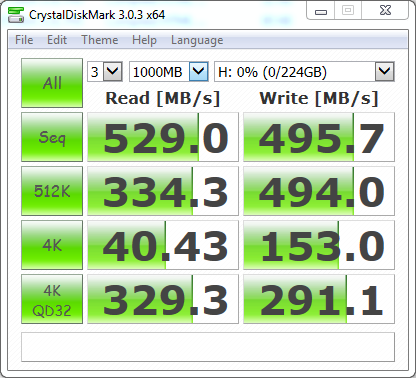CRYSTAL DISK BENCHMARK VER. 3.0 X64
Crystal Disk Benchmark is used to measure read and write performance through sampling of random data which is, for the most part, incompressible. Performance is virtually identical, regardless of data sample so we have included only that using random data samples.
Crystal Disk Mark is showing us a high of 529MB/s for sequential read and 495MB/s sequential write. Both 4K reads and writes are very good with over 40MB/s for 4k read and over 150MB/s for 4k writes.
The toughest benchmark available for solid state drives is AS SSD as it relies solely on incompressible data samples when testing performance. For the most part, AS SSD tests can be considered the ‘worst case scenario’ in obtaining data transfer speeds and many enthusiasts like AS SSD for their needs. Transfer speeds are displayed on the left with IOPS results on the right.
Our AS SSD result provided a Total Score of 1111. The SanDisk Ultra II reaches a max of 522MB/s and 478MB/s for sequential read and write tests. 4K results are also very good, 4K read and write reached 37MB/s and 120MB/s respectively. In the IOPS we see it reaches a max of 83,369 read IOPS and 77,459 write IOPS.
To complement this, the AS SSD Copy Bench presents us with transfer speeds for different file types. The Ultra II did well reaching a high of 458MB/s for the ISO test.
ANVIL STORAGE UTILITIES PROFESSIONAL
Anvil’s Storage Utilities (ASU) is the most complete test bed available for the solid state drive today. The benchmark displays test results for, not only throughput but also, IOPS and Disk Access Times. Not only does it have a preset SSD benchmark, but also, it has included such things as endurance testing and threaded I/O read, write and mixed tests, all of which are very simple to understand and use in our benchmark testing.
 In Anvil Storage Utilities the max sequential read reaches 511MB/s and sequential write is just shy of the rates specification, coming in at 476MB/s. 4K speeds are good, 39MB/s for read and 143MB/s for write.
In Anvil Storage Utilities the max sequential read reaches 511MB/s and sequential write is just shy of the rates specification, coming in at 476MB/s. 4K speeds are good, 39MB/s for read and 143MB/s for write.
 The SSD Review The Worlds Dedicated SSD Education and Review Resource |
The SSD Review The Worlds Dedicated SSD Education and Review Resource | 

> write speeds dropped to around 240MB/s. This is still pretty good,
especially considering it is such a compact design with only four TLC
NAND packages.
I wonder how other capacities perform. This kind of write is avarage at best, since even older 840 topped that.
But, if this is priced right, its a great alternative to MX100. Lets just hope this thing doesn’t have the same issues as 840 and 840EVO, as those drives experince quite a drop in read performance on cold files. Its actually an issue, that many have nowdays.
I wonder as well. And yes, I believe this drive is a great alternative to the MX100.
I have taken note of the 840 cold files issue when it first appeared as well, it is a little disappointing. Hopefully a simple F/W update can fix it. Otherwise, I am pondering if it could be a TLC NAND cause.
I suspect (again, i’m only making wild guesses here) it has to be TLC, since its only limited to 840/840evo, while 840pro is not affected. Given how many states TLC must hold and very small litography its quite possible, that data retention is dropping faster than we though. Or it could be something entirely different.